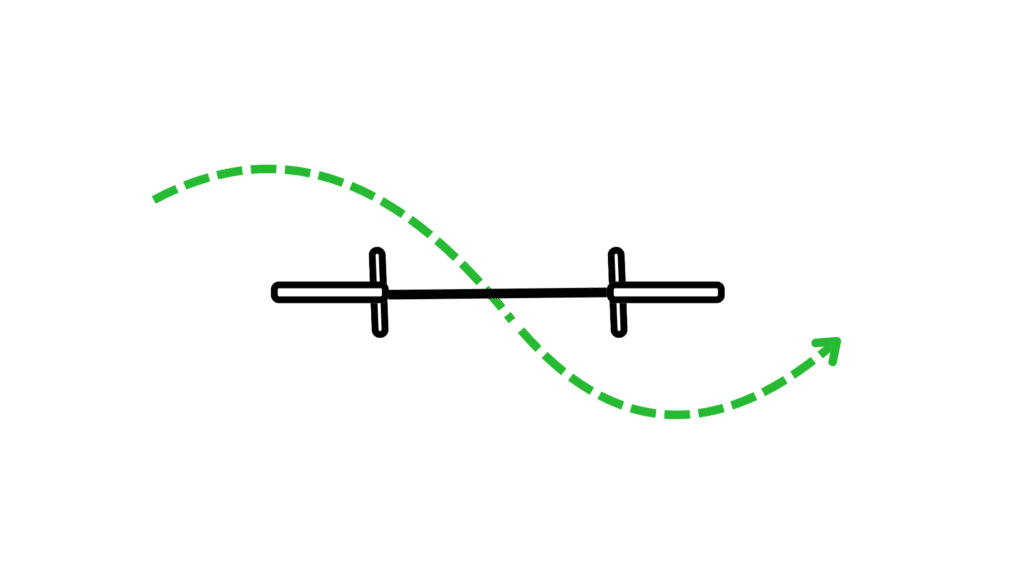As agility handlers, one of the biggest challenges is deciding what kind of handling to use when walking a course. In particular, there’s one type of course section that can make us scratch our heads a little, the S-line. Let’s break down the S-line and explore how we can handle it, making it both clear and efficient for our dogs.
If you haven’t heard of an S-line before, this is what it looks like:

What Is an S-line in agility?
Simply put, an S-line refers to a S-shaped line on the agility course, where the dog approaches the jump on one wing and exits on the opposite wing. This kind of line can be tricky because it demands a lot of precision in timing and handling from us as the handler, and our dogs need to have a high obstacle focus to perform the jump efficiently.
The S-line can come in different forms: loose, tight, or mixed, each requiring its own handling approach. But don’t worry, we’ve got strategies for each!
Find out more in our recent webinar on S-lines.
Different kinds of S-lines you’ll see on the agility course
- Loose S-lines
In loose S-lines, your dog has more freedom to stay extended, meaning they have a little more space to approach and exit at full speed. The challenge for us here is timing—if we don’t cue the dog in the right moment, we might see knocked bars and wings, or refusals. Common handling techniques for these lines include the Japanese and Running on the Dog’s Line. - Tight S-lines
Tight S-lines are more restrictive for the dog, often requiring them to collect on approach and exit. This situation can be hard for lower drive dogs and if your timing is not great, you easily risk refusals or back-jumps. Techniques like Forced Front Cross to Jaakko turn or German Turn are effective here . - Mixed S-lines
These involve both extension and collection. For example, one side of the S might require the dog to extend, while the other side demands more collection. This requires careful timing to give the dog as much information as possible. Handling techniques like the Whisky Cross come into play .
Foundation agility skills your dog needs for S-lines
S-lines may look simple, but they require your dog to have several foundation skills mastered. When your dog has strong foundation skills, all aspects of agility feel easier and S-lines are no exception.
Necessary foundation skills for S-lines include:
- Obstacle focus: Your dog needs to be locked in on the obstacle in front of them, not distracted by the handler’s movements.
- Commitment: The dog must stay committed to the obstacle even when the handler is moving in the opposite direction.
- Lead changes: This is a big one! When your dog changes direction, they need to adjust which leg is leading. Proper timing from you is key to avoiding refusals or knocked bars.
Handling techniques for S-lines
Now, let’s talk about how we can guide our dogs through these tricky lines. More information and examples can be found in our recent webinar on S-lines. Each type of S-line demands different techniques:
- For loose S-lines, we focus on keeping the dog in extension as they flow through the line. Techniques like Running on the Dog’s Line or the Backside Blind are fantastic here .
- For tight S-lines, we need to cue the dog to collect, ensuring they jump the middle section of the bar. Forced Front Cross to Front Cross and Backlap are useful techniques for this situation
- For mixed S-lines, a mix of extension and collection is needed. Here, Whisky Cross or Forced Front Cross might be the way to go, depending on the situation .
Watch a video with some examples here:
[embedded content]
How to know which technique to choose
The choice of handling technique will depend on several factors, including your dog’s speed, drive, and natural working distance. Not every dog is the same, and not every course is the same, so the best technique for one team might not be the best for another .
It’s also important to consider the context of the course itself. What’s the line like before and after the S? Is there a critical point in the course that requires a particular technique? These are all things to consider when you’re strategizing your handling approach. Learn more in our recent webinar on S-lines.
Take Your Handling to the Next Level
Mastering the S-line isn’t just about learning a specific handling technique. It’s about understanding your dog’s perspective and how they read our body language, predicting their movements, and adjusting your own timing and positioning. If you’re looking to dive deeper into these aspects of agility, OneMind Dogs online learning is for you!
https://www.oneminddogs.com/blog/understanding-and-handling-s-lines-in-dog-agility/
